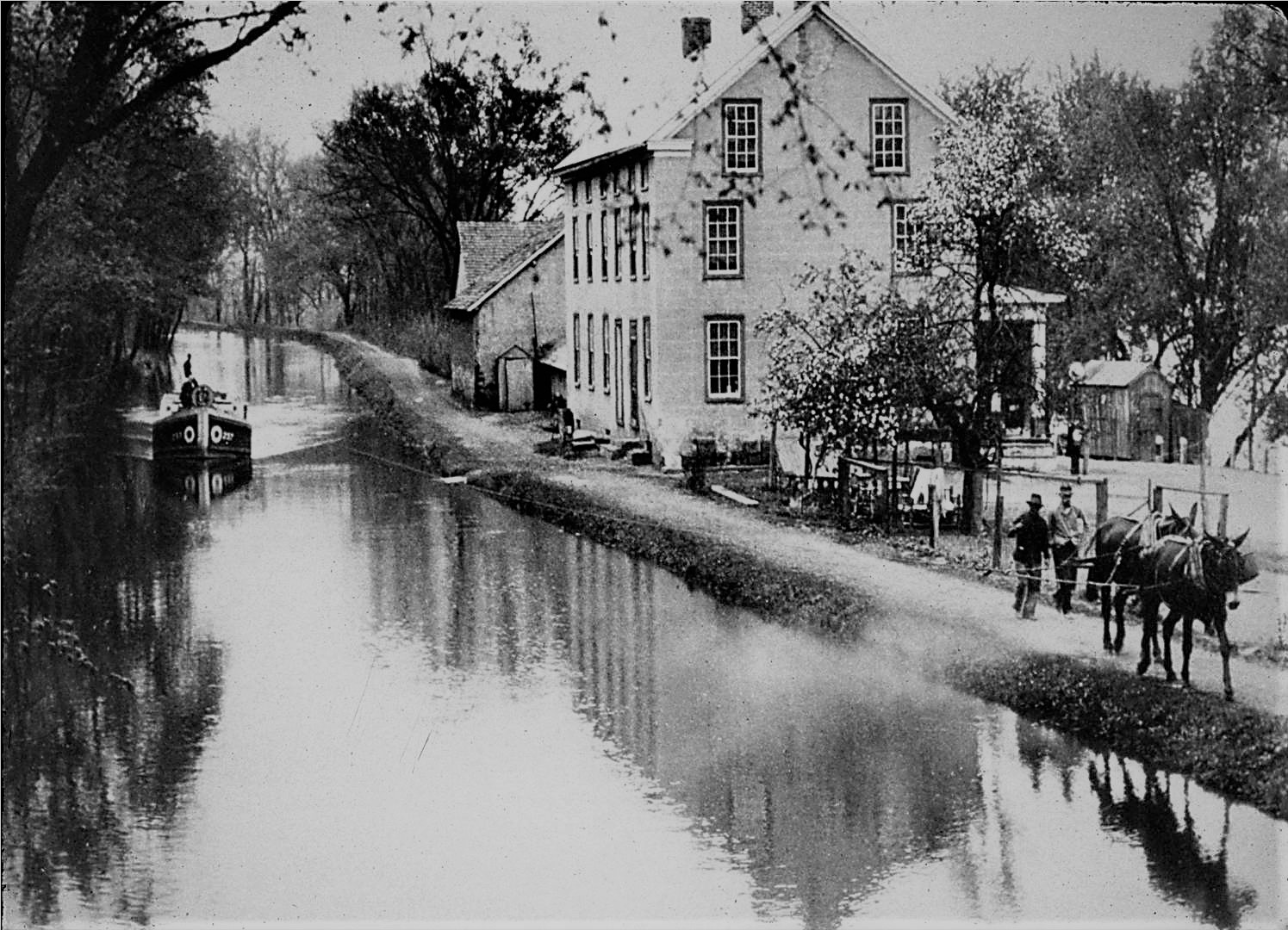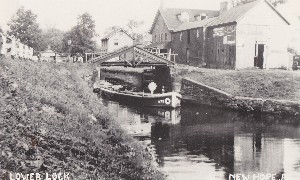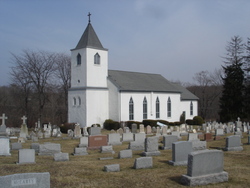The Singleys, of whom my mother was a one, came originally from Oberhausen (now part of Rheinhausen) in the Breisgau of Baden. The Breisgau is the land between the Rhine and the Black Forest, and was formerly part of Farther Austria, i.e., Hapsburg lands far to the west of Austria. When the Holy Roman Empire was dissolved at the end the Napoleonic kerfufffle, the Breisgau was ceded to Baden..
The name Singley has been spelled with a wonderful diversity, both here and in Baden. Among the variants have been Zengley, Zengli, Zängle, Zangl, Zaengle, Zenglin, Sengla, et al.. Die Zange means "pliers," "forceps," or "tongs." The "-li" ending is the southern German take on the standard German diminutive "-lein" e.g. Hans >Hansl.
The first Singley of whom we have definite knowledge was
1. Johann Georg Zanglin, who married Anna Maria Mergler on 20 Apr 1720 at the Catholic Church in Oberhausen. The KIrchenbuch goes on to name eight children subsequently born to them between 1720 and 1735, all in Oberhausen. Georg himself would have been born shortly after The Nine Years’ War, when France finally gave up all rights to the Breisgau in exchange for retaining rule over the the Sundgau [Elsass or Alsace], now a German-speaking region in France. The armies of Louis XIV had devastated the Breisgau, and his general Mélac's name became a synonym for "murderer and arsonist" as well as a common dog's name. Georg would have been born in the aftermath of that. Since the Oberhausen/Niederhausen baptismal records begin in 1687 and the marriages begin in 1708, it is not likely that earlier Singleys will be discovered.
2. Johann Michael Zenglin, the third child of Georg and Maria, was born 3 Sep 1724. Oberhausen Church records
(in script, in Latin) for 1740-1783 are missing and connections must be inferred from later entries that often name parents, spouse, and the like. He married Magdalena Sedlar and they had at least two children Lorenz [b. c. 1760 in Oberhausen, based on his age in his marriage and death records, and Maria Anna [b.c. 1762]. There were likely others.
3. Lorenz Zängle, born c. 1760, married first Martha Mittleholz with whom he had six children. After she died in 1793, he married on 10 Feb 1794 Petronella Lurm from nearby Herbholzheim. Their seven children made 13 total kids [in case you're keeping count] a veritable cornucopia of Singleys. Lorenz died 22 Jun 1824. During his lifetime, the French invaded yet again, this time in the name of first Republicanism and then of Bonapartism, and the Breisgau was again devastated. In 1797, The Hapsburgs shifted the Breisgau from the Austrian Vorlande to the ex-duke of Modena as a consolation prize for losing his own country to the French; but shortly afterward, in the 1805 Treaty of Pressburg, after the French kicked Austrian butt, Napoleon gave the area to his newly-created Grand Duchy of Baden, and after the wars, it remained with Baden. The Confederation of the Rhine made its brief appearance on the world stage when 16 princely states declared their independence from the Holy Roman Emperor [becoming thereby subordinated to the French Emperor]. Shortly after, HRE Emperor Francis II announced the dissolution of the Empire and became Francis I of Austria. How much Lorenz cared about any on this is anybody's guess.
After the war, Baden was joined to the newly-formed German Confederation, to provide a buffer state against future French invasions [cf. The Watch on the Rhine]. Grand Duke Karl-Ludwig of Baden started the "administration of the Rhine," a series of dams, diversions, and other engineering works that transformed the upper Rhine for navigation and fisheries. When Karl Ludwig died in 1818, he was succeeded by his uncle Ludwig I. In 1820, Ludwig secured the continued existence of the University of Freiburg, which was renamed the Albert-Ludwig University. But he also revoked many of the reforms his nephew had tried. A time bomb began ticking.
On 22 Jun 1824 Lorenz Zängle died at Oberharmersbach in Ortenau, the county just north of the Breisgau. (Where this information comes from, TOF is uncertain, and it has not been verified.)
 |
| Friedrich Hecker |
4. Franz Josef Anton Zängle (b. 12 Feb 1799), third son of Lorenz and Petronella, married Elizabeth Maier on 3 Mar 1828 in Oberhausen. They had five children, two of whom died in infancy. Surviving were Anton (b. 29 Jun 1829), Theresa (2 Apr 1830), and Johann (18 Jun 1836). In overlapping records: marriage, baptisms of children, and burial, he is referred to by virtually every 1- and 2- word combination of his names: Franz, Josef, Anton, Franz Josef, Franz, Anton, and Josef Anton.
 When Anton Sr was 49 [and Anton Jr was 19], the Revolution of 1848 broke out across the Germanies. [See 'time bomb,' mentioned earlier] In Baden, one insurrection was led by Friedrich Hecker. who marched his 'army' up through Baden, pulling in volunteers from Emmendingen and elsewhere. [Oberhausen was a village in Emmendingen.] But it never found widespread public support, even from other Republicans, and it was crushed by troops from Baden, Hesse, and Bavaria. Sporadic fighting continued for another year. Hecker [along with Franz Sigal, another leader of the Revolution] wound up in the USA, where they helped found the Republican party [and Sigal became a Union general in the Civil War]. The insurrection is celebrated in the popular Badener song, the Heckerlied,.
When Anton Sr was 49 [and Anton Jr was 19], the Revolution of 1848 broke out across the Germanies. [See 'time bomb,' mentioned earlier] In Baden, one insurrection was led by Friedrich Hecker. who marched his 'army' up through Baden, pulling in volunteers from Emmendingen and elsewhere. [Oberhausen was a village in Emmendingen.] But it never found widespread public support, even from other Republicans, and it was crushed by troops from Baden, Hesse, and Bavaria. Sporadic fighting continued for another year. Hecker [along with Franz Sigal, another leader of the Revolution] wound up in the USA, where they helped found the Republican party [and Sigal became a Union general in the Civil War]. The insurrection is celebrated in the popular Badener song, the Heckerlied,.
Whether Franz Josef Anton or his son participated in the insurrection, we don't know. There seems no death record for Anton Sr, and his widow and children show up in Bucks Co. in the 1850 Census, so the timing and circumstances seem right. But there was also a famine in 1846, one of the reasons Hecker's army contained so many journeymen: the economy was in the pits. Whether it was famine or fighting, Josef Anton perished and
The Singleys hauled ass for the States, Elizabeth and her three kids, Anton, Theresa, and Johann, wound up in Nockamixon Twp., Bucks Co., PA, where Anton Jr and Johann became Anthony and John, and Zängle became Singley (at least fairly often). In the 1900 Census, a John Singley living in a Doylestown retirement home reported that he had immigrated in 1843. His sister Theresa is said in a history of the Freeh family to have emigrated when she was 17, which would put it at 1847, so we can say they emigrated between 1843 and 1847. In any case, the earliest record of them in the USA that I have found so far is when Theresa was married at Haycock Run in 1850 to Leonard Früh. (And the Free and Singley households lived close by in Nockamixon.)
The Church Record book for St John the Baptist of Haycock Run is in Latin handscript, making it just as easy to read as the Oberhausen Kirchenbuch in Baden. Thank you, Fr John Joseph Gonchar.
5. Anthony Singly (als Ziegler) wed Margaret Weaver (Vievier) at St John the Baptist on 19 Mar 1853. The Weavers appear to have been an old Bucks family, but we know almost nothing about them. (A Margaret Weaver of the right age had appeared in Nockamixon #317 in 1850 in the household of Mary Weaver (46). It was close enough to where Elizabeth's dwelling was to be a good guess at Margaret's mother.)
By 1860, the Census records #299 boatman Anthony Singly (31) with wife Margaret (26) and three children:John (6), Mary (3), and William (1). His mother is at #266 Mary Singley (55) with her youngest son John Singley (22). Theresa Free has gone off to Iowa with her husband and kids.
 |
| The Nockamixon Cliffs |
In the meantime, additional families from Oberhausen/Niederhausen have joined the Zängles and Frühs in Nockamixon. Names like Schwähr, Metzger, Rieß, and the like begin to swamp the McCarthys and the Bucks in the St John Church Records. A chapel, Marienstein, was built on the road to Ringing Rocks atop the Nockamixon Cliffs.
By the 1870 Census, we find Anthony Sengla (40) at dwelling #281. He is still boating on the canal and has Real Estate worth $1600 and Personal estate worth $875. ($32,000 and $17,000 today.)
With him are wife Margaret (35) and children: John (16), William (15), Mary (14), Margaret (10), and Anthony (4). Elsewhere, at dwelling #247, Elizabeth Sengla (69) is keeping house with a $300 real estate and $600 personal estate. There is no sign of younger brother John and a computer search in the 1870 data does not find a match for him. As a boatman, he may not have been home at the time.A map of a portion of Nockamixon township in 1876 shows the location of key households: Anthony Singley, Sebastian Schware, and Frank Metzger. An Isaac Weaver, possibly a brother-in-law lives up the road to the east, while L.Free resides ESE of the homestead. Further south, SSE of Marienstein chapel is a Frank Singly, who may be a cousin of Anton.
On 6 Sep 1878, grandmother Elisabeth (Meier) Zaengle (82) died and was buried at John the Baptist Catholic, Haycock Run, Bucks Co, PA.
That brings us to the 1880 Census, although individual baptisms, marriages, and burials are recorded in the meantime in the John the Baptist Church Record Book. In the Census, we find at #275 in Nockamixon, Anthony Sengly (51) a boatman, Margret Sengly (45), Maggie Sengly (19), Anthony Sengly (16), and Anna Sengly (9)
Of the other children, older sister Mary Singley (24) has married Charles Fleck (32) and they have
four sons, ages 5 and below. So they were evidently wed about 1875, when Mary was
19. Older brother John Zengly (26) has become a boatman and is living at #245 in Tinicum Twp with his wife Rebecca (23) and son William (4/12) in the household of father-in-law Jeremiah Templeton, also a boat man. John and Rebecca are the ancestors of the Singleys of Upper Black Eddy, where they will buy the general store in 1911. Singley's General Store on Singley Lane near the UBE-Milford Bridge sold goods to the canal boaters and their passengers. (The store's main entrance faces the canal bank, not the town.) John apparently converted to his wife's Lutheranism. since records now appear in the Upper Tinicum Lutheran Church. Perhaps this engendered ill feelings with the rest of the family, for when broPat and T visited the store in the 1970s and told the proprietor of our Singley connection, he turned about without a word, walked away, and did not return. A near-century seems a long time to hold a grudge; but then Germans are famously stubborn.
Elsewhere in the 1880 Census, Anton's brother John is a 45-year old unmarried boatman, boarding at C.L.McGee's boarding house, #219 in Tinicum Twp.
The remainder of Anthony's children married in the ensuing decade and started their own families: Margaret married Thomas Agnew in 1881; Anna married Lawrence Metzger in 1887; and Anthony Jr wed Lawrence's baby sister, Sarah Jane Metzger in 1889. Finally, William Henry married Victoria Theresa Fleming in 1891.
Anthony and the Metzgers had moved to Kiefer St.above Delaware Ave. in South Bethlehem by 1890. This was a burgeoning area of Salisbury Twp. that would shortly (in 1893) be incorporated as Fountain Hill Borough, named from Tinsley Jeter's Fontainbleu Estate.
On 3 Jun 1891, Margaret Weaver Zengly died and was buried at Haycock Run. (The entry in St John burial records also gives her maiden name and her birth date.)
Mary Fleck's husband died in 1892, and in 1900 she remarried, to Frank H. Thoma.
25 Feb 1902 Anthony Zaengle (73) died and was buried at Haycock Run. By this time his children are all over the place.
6. Anthony W. Singley. This makes three Anthonys in a row, so you can see how matters might get confusing, especially when Ancestry's artificial stupid is sorting out records. The records do not distinguish between sr. and jr. or in this case iii.
The baptismal certificate for their son at Bethlehem Church of the Holy Ghost reads Harry F. (Zengle) Singley, so the name was in the process of changing.
 |
| Harry Singley, Helen Schwar, and Sarah Jane Metzger Singley |
Anthony Singly (35) is recorded as having been born May 1865 and married eleven years. He is a day laborer who owns the house on Delaware St (Fountain Hill) in which he lives. In the household with him are his wife Sarah J. (30 b.Aug 1869) and four children; viz., Charles N. (9 b Nov 1889), Harry F. (7, b.Jul 1892), Vena (6, b.Nov 1893), and James F. (5, b.Oct 1894). Vena is named after Sarah's mother, Lovina (Steidinger) Metzger.
TOF has no photograph of Anthony and only one of Sarah. (see right)
Two siblings are living in Easton:
- Anthony's brother William (38) is living with his wife of eleven years, Theresa (30) and child William E. (11) at 81 Canal St in Easton, where he works as a lock-tender. Since the address is at the very tip of Canal St., where it bends into Third St., the lock he tended may have been the headlock for the Lehigh Canal.
- Sister Anna and Lawrence Metzger are at 219 N.Green St, Easton.
and three are living in Bridgeton, Bucks Co., which was broken off of Nockamixon in 1890.
- Sister Margaret and Thomas Agnew
- Sister Mary has been married less than a year to Frank Thomer, with three children from her first marriage (Fleck).
- Oldest brother John W. (45), a day laborer, with wife Rebecca (42), four sons, and two daughters: William (20) Charles (18), Harry (11), Dory (9), Minerva (4), and Geneva (10/12).
William and John are still spelling their name "Zengly" (or the census taker is) but Anthony has segued to "Singley." In an enormous Bible once belonging to Anthony, he wrote his name "Zengly" in the front flyleaf and "Singley: in the rear.
In the 1910 Census:
Anthony Singley (44) a heater at the Steel Works, living at 1048 Delaware Ave, Fountain Hill, with Sarah (39), and their children: Charles W. (19) and Harry F. (17) both apprentices at the Steel. James F. (15) is a news agent at the station, presumably the LVRR train station. And Lavinia M. (13)
In Easton. William Henry Singley (43) at 232 Philadelphia Rd, Easton,
is foreman in the power house living with Theresa V (41) and children: William E
(21) laborer at odd jobs, Herbert C (18) clerk at grocery store, Edward
W (15) silk finisher at silk mill, Catherine (12), Mildred (8), and Alouisus (4)
In Bridgrton, John W Zingley (54) is a bank boss on the canal with Rebecca (52) and Charles (28), a bricklayer, Harry (21) and Dory (19). both winders at the Broom works, Minerva (14) and Geneva (10).
TOF will not bother further tracking the Flecks, Agnews, Thomas, or Metzgers, let alone the Frees in Iowa and others from the earlier generation.
 |
| Harry and Helen prepare for marriage |
Then came the Great War. Harry Singley, whose nickname then was "Banty", was drafted on 20 Dec 1917. He had been married for four months. Before leaving for France, Harry moved to Easton, where he lived with his wife's parents at 332 St Joseph St., just across the street from the then-convent.

 The 79th Division, composed primarily of draftees from Maryland
and Pennsylvania, had been activated at Camp Meade, MD, in August 1917, and Harry was placed in Co D 304 Engineers. After a year of training the company sailed overseas on 09 Jul 1918 from Hoboken, NJ, aboard the SS La France.
The 79th Division, composed primarily of draftees from Maryland
and Pennsylvania, had been activated at Camp Meade, MD, in August 1917, and Harry was placed in Co D 304 Engineers. After a year of training the company sailed overseas on 09 Jul 1918 from Hoboken, NJ, aboard the SS La France. The 79th Division saw extensive combat in the Meuse-Argonne Offensive,
where it earned the name of "Cross of Lorraine" for their defense
of France. This was the same offensive in which George Marshal displayed his logistic prowess, George Patton led his first tank attack, and Harry Truman conducted his artillery defense against a German counter-attack. This was also the offensive in which the famous Lost Battalion was temporarily lost.
 |
| Ruins of Montfaucon |
"It was on Sept. 26 when the big drive started in the Argonne Forest and I saw all kinds of things that I never witnessed before. We started out on the night of the 25th. At 9 o'clock we commenced a tank road and worked our way almost to the German's front line trenches. At 2:30 one of the greatest of all barrages was opened. It was said that between 3500 and 4000 guns, some of them of very large calibre, went off at that hour just like clock work. We worked on this road under shell fire until about 3:45 and then went back until the infantry went over the top at 5 o'clock. We followed with the tanks. That is the way the Americans started and kept pounding and pushing ahead until the great day on Nov. 11. ...
 |
| Harry Singley, 304th Engineers, Rainbow Division |
"Somebody will wake up soon when the boys get back to the States....The division returned to the United States on 10 May 1919 and was mustered out at Camp Dix, NJ. Nobody woke up: Twenty years later they had to do it all over again.
 |
| 201 St Joseph St |
Harry got busy. He established a home at 201 Sr. Joseph St. on the corner with St John St. (The house is no longer there, having been demolished when St John St was widened.) His uncle William had lived at 383 St Joseph, but died in 1919. His widow was still there. His two brothers, Charles and Floyd, and his sister, Lavinia, remained in Fountain Hill.
Harry and Helen's first children, twins Ralph and Paul, were born already on 10 May 1920, one year to the day after he got out of the Army.
 |
| Ralph and Paul flank Rita |
Harry worked as a bricklayer and a bricklayer foreman for several contractors over the years and worked his way up in the Union to be Finance Manager of Local 34. He was also active in Rice-Ebner Post 388 of the American Legion (which had been founded by WW1 vets in 1919).
An odd thing is that the 1930 Census, in addition to listing Harry, his wife, and his three children, also lists at the same address, a fourth child: John Singley, age 5. Pere thought he have been a cousin staying with them on census day. One clue is that, unlike the others in the family, he is checked off as having lived on a farm. Now, there was a John Singley in Bridgeton Twp, Bucks Co., son of another Harry Singley. (There are always two of anything!) This Harry was the son of John Singley, the older brother of Anthony W. So, little John was a 2nd cousin of Ralph, Paul, and Rita. (The two Harrys were cousins.) Whether this was in fact the John who was staying at Folk St. in 1930 cannot be known. There are all sorts of errors census takers made, starting with the names themselves: John might have been a Schwar staying in a Singley house, for all we know.
The 1940 Census is the last one open to the public. It lists the Singley family at 530 Folk St. with
- Harry (48), a bricklayer working on his own account, and had completed 8th grade
- Helen (44) had completed 8th grad
- Ralph (19), a stenographer in the office of the ironworks, had completed high school
- Paul (19), a bookkeeper in the office of a lumber company, had also completed high school.
- Rita (16) had completed sophomore year in HS
In subsequent years, the occasional Easton City Directories provide a Census substitute.
- 1944 Easton City Directory: Harry F (Helen M), brklyr; Paul L, USA, Ralph F (Helen F) USA, Rita M, sten,
- 1947 Easton City Directory Harry F (Helen M), brklyr; Paul L, student, Ralph F (Helen F), Rita M, sten.
In 1944, the twins were in the Army Air Corps, guarding the Panama Canal Zone. But one notices that Ralph had already married Helen F. Deck (the Decks were also from Oberhausen), and they were living with his parents. Rita was a stenographer at IIRC Taylor-Wharton Iron & Steel Company. This is likely the 'steel company' where the 1940 Census said her brother Ralph had been a stenographer. I also remember the lumber company where Paul worked was Zearfass-Hilliard (and the odor of fresh cut wood in houses under construction wafts forth from my childhood memory).
In 1947 Rita married Joseph F. Flynn and later that year their first son, Michael, would be born. For a while everyone was living at 530: Harry and Helen Singley, Ralph and Helen Singley, Rita and Joe Flynn, Ralph's two kids: Little Paul and Mariellen, and Rita's kid, Michael, then Dennis. Also Big Paul, our uncle. Under modern definitions, we were homeless.
 |
| Little Paul, Mariellen, and Mike at 530 |
But then, like seeds bursting from a pod, 530 scattered colonists. Ralph and Helen moved three houses up the street. Rita and Joe moved two houses down the street. When Big Paul married Lois Smull, he stayed at 530 and soon inherited it. In good German fashion, Big Mom gifted her three children with trees: three sibling sycamores to celebrate their new houses. Only one still survives. The other two have gone to that Great Woodpile in the Sky.
Harry "Guv" Singley died on 28 Feb 1951 at age 58, after a brief illness. TOF had always heard that he never quite recovered from being gassed in the War.
Helen Myrtle Schwar Singley died a few years later, on 21 Nov 1956.
At this point, we have begun talking about people who are still alive, and so we politely draw the curtain.











No comments:
Post a Comment